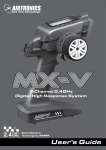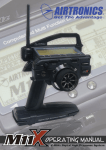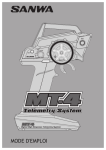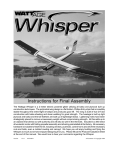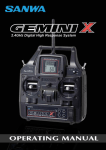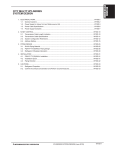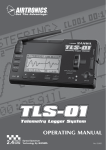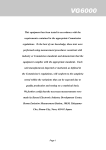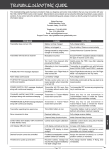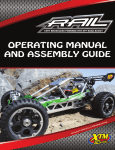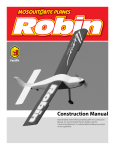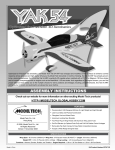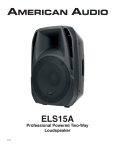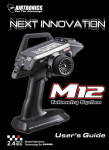Download AIRTRONICS MX-V Specifications
Transcript
Page 1 TABLE OF CONTENTS Introduction.......................................................................................................................................................Page.2 Packaging.........................................................................................................................................................Page.2 Usage.Precautions...........................................................................................................................................Page.3 . FCC.Compliance.Statement......................................................................................................................Page.3 . 2.4GHz.Frequency.Band.Precautions.......................................................................................................Page.3 . Transmitter.Precautions.............................................................................................................................Page.4 . Receiver.Precautions.................................................................................................................................Page.4 Features.and.Specifications.............................................................................................................................Page.5 . System.Features........................................................................................................................................Page.5 . System.Specifications................................................................................................................................Page.5 . Optional.Items............................................................................................................................................Page.5 . Customer.Service......................................................................................................................................Page.5 Features.Familiarization...................................................................................................................................Page.6 . Transmitter.and.Receiver.Features.Diagrams...........................................................................................Page.6 . Features.Descriptions................................................................................................................................Page.7 . Servo.Connectors......................................................................................................................................Page.7 System.Connections........................................................................................................................................Page.8 . Transmitter.Battery.Installation..................................................................................................................Page.8 . Receiver.Connections.and.Mounting.........................................................................................................Page.8 . Transmitter.and.Receiver.Battery.Options.................................................................................................Page.9 . Servo.Recommendations..........................................................................................................................Page.9 LCD.and.Programming.Keys..........................................................................................................................Page.10 . Multi-Function.LCD.Overview..................................................................................................................Page.10 . Programming.Key.Functions...................................................................................................................Page.10 System.Setup.................................................................................................................................................Page.11 . Transmitter.and.Receiver.Binding............................................................................................................Page.11 . Throttle.Fail.Safe.Programming...............................................................................................................Page.11 Programming.and.System.Use......................................................................................................................Page.12 . Programming.Menus.Flow.Chart.............................................................................................................Page.12 . MDL.-.Model.Select.................................................................................................................................Page.12 . REV.-.Servo.Reversing............................................................................................................................Page.13 . EPA.-.End.Point.Adjustment....................................................................................................................Page.14 . EXP.-.Exponential....................................................................................................................................Page.15 . ABS.-.Anti-Lock.Braking..........................................................................................................................Page.16 . NAME.-.Model.Naming............................................................................................................................Page.17 . Digital.Trim.Memory.................................................................................................................................Page.17 . Dual.Rate.................................................................................................................................................Page.18 . Low.Voltage.Alarm...................................................................................................................................Page.19 Troubleshooting.Guide...................................................................................................................................Page.20 Reference.......................................................................................................................................................Page.21 . Glossary.of.Terms....................................................................................................................................Page.21 . Index........................................................................................................................................................Page.22 iNTrOduCTiON Congratulations! We appreciate your purchase of the Airtronics MX-Sport 2.4GHz FHSS-2 radio control system. This Operating Manual is intended to acquaint you with the many unique features of your radio control system. Please read this Operating Manual carefully so that you may obtain maximum success and enjoyment from the operation of your new radio control system. The MX-Sport 2.4GHz FHSS-2 radio control system has been designed for the utmost in comfort and precise control of all types of model cars and boats. We wish you the best of success and fun with your new purchase. Additional 2.4GHz receivers can be purchased and paired with the MX-Sport transmitter through the Binding operation. Please note that due to differences in the implementation of 2.4GHz technology among different manufacturers, only Airtronics brand 2.4GHz FHSS-2 surface receivers are compatible with your radio control system. Please visit your local Airtronics dealer or our website at http://www.airtronics.net for more information. PACkAgiNg The packaging of your Airtronics MX-Sport 2.4GHz FHSS-2 radio control system has been specially designed for the safe transportation and storage of the radio control system's components. After unpacking your radio control system, do not discard the packaging materials. Save the packaging materials for future use if you ever need to send your radio control system to us for service, or to store your radio control system if you don't plan on using it for an extended period of time. Page 2 USAGE PRECAUTIONS general Safety This is a high-output full-range radio control system that should well exceed the range needed for any surface model. For safety, the user should perform a range test at the area of operation to ensure that the radio control system has complete control of the model at the farthest reaches of the operational area. Rather than operating the model, we recommend that the user enlist the help of a fellow modeler to walk the model to the farthest reaches of the track (or for boats, to walk the shore line well in excess of the operational distance of the boat), then test for proper operation. l l l 'Safety First' for yourself, for others, and for your equipment. Your model can cause serious damage or injury, so please use caution and courtesy at all times. Observe all the rules of the field, track, or lake where you operate your radio control equipment. If at any time during the operation of your model, should you feel or observe erratic operation or abnormality, end your operation as quickly and safely as possible. DO NOT operate your model again until you are certain the problem has been corrected. TAKE NO CHANCES. l l l Please waterproof the receiver and servos by placing them in a water-tight radio box when operating R/C model boats. If you have little to no experience operating R/C models, we recommend you seek the assistance of experienced modelers or your local hobby shop for guidance. The Low Voltage Alarm will sound when the transmitter battery voltage drops to 8.5 volts. If this occurs, stop using the transmitter as soon as possible, then replace or recharge the transmitter batteries. fcc compliance statement This equipment has been tested and found to comply with the limits for a Class B digital device, pursuant to Part 15 of the FCC Rules. These limits are designed to provide reasonable protection against harmful interference in a residential installation. This equipment generates, uses, and can radiate radio frequency energy and, if not installed and used in accordance with the operating instructions, may cause harmful interference to radio communications. However, there is no guarantee that interference will not occur in a particular installation. If this equipment does cause harmful interference to radio or television reception, which can be determined by turning the equipment off and on, the user is encouraged to try to correct the interference by one or more of the following measures: l Reorient or relocate the receiving antenna. l Increase the separation between the equipment and the receiver. l Connect the equipment into an outlet on a circuit different from that to which the receiver is connected. l Consult the dealer or an experienced technician for help. This device complies with Part 15 of the FCC Rules and with RSS-210 of Industry Canada. Operation is subject to the following two conditions: 1) This device may not cause harmful interference, and.... 2) This device must accept any interference received, including interference that may cause undesired operation. WARNING: Changes or modifications made to this equipment not expressly approved by Airtronics may void the FCC authorization to operate this equipment. RF Exposure Statement This transmitter has been tested and meets the FCC RF exposure guidelines when used with the Airtronics accessories supplied or designated for this product, and provided at least 20cm separation between the antenna and the user's body is maintained. Use of other accessories may not ensure compliance with FCC RF exposure guidelines. 2.4GHz frequency band precautions l l The 2.4GHz frequency band may be used by other devices, or other devices in the immediate area may cause interference on the same frequency band. Always before use, conduct a bench test to ensure that the servos operate properly. Also, conduct checks with the transmitter as distant as possible from your model. The response speed of the receiver can be affected if used where multiple 2.4GHz radio controllers are being used, therefore, carefully check the area before use. Also, if response seems slow during use, stop your model immediately and discontinue use. Page 3 Continued on Next Page uSAgE PrECAuTiONS 2.4gHz FrEquENCy BANd PrECAuTiONS, CONTiNuEd.... l If the 2.4GHz frequency band is saturated (too many transmitters on at once), as a safety precaution, the radio control system may not bind. This ensures that your radio control system does not get hit by interference. Once the frequencies have been cleared, or the saturation level has dropped, your radio control system should be able to bind without any problems. TrANSmiTTEr PrECAuTiONS l l l Turn the transmitter ON first and then turn the receiver ON. After using your model, turn the receiver OFF first, then turn the transmitter OFF. It can be dangerous if you activate the components in reverse order as the servos may start up inadvertently. Before use, double-check that the transmitter and receiver batteries have sufficient power. Never touch the transmitter antenna during use. Doing so may cause a reduction of transmitter output, resulting in a loss of signal. l Do not bend the antenna or damage could result. l During use, the transmitter should be held so that the antenna is vertical at all times. l l l l Do not expose the transmitter or any other components to excessive heat, moisture, fuel, exhaust residue, etc. Do not press the Bind Button during use. The signal is interrupted while the Bind Button is pressed. It may also require a short time to restore the signal after releasing the Bind Button, which can be dangerous. If the outer case becomes dirty, it can be cleaned with a soft dry cloth. If the outer case becomes soiled, it can be cleaned with a damp cloth and liquid detergent. Do not use any solvents to clean the outer case. Solvents will damage the finish. rECEivEr PrECAuTiONS l The antenna wire is delicate. Handle with care. Do not pull on the antenna wire with force. l Do not cut or extend the antenna wire. l l l l l l l l The antenna wire should be installed into a vertical plastic tube per your particular model's assembly instructions. Keep the receiver antenna as far away from the motor, battery, and electronic speed control as possible. There is a danger of runaway operation if connectors shake loose during use. Make sure that the receiver, servo(s), and switch connectors are securely fitted. The receiver is susceptible to vibration, shock, and moisture. Take appropriate measures to protect against vibration and moisture. Failure to take appropriate measures could result in runaway operation or damage to the receiver. We suggest wrapping the receiver in shock-absorbing foam rubber when installing it into your model. When installing the receiver, avoid contact with any carbon or metal chassis components. Antenna Wire Antenna Tube Contact between metal parts mounted on a model can result in electrical noise, which can adversely effect receiver performance and possibly result in runaway operation or damage to your model. With electric-powered models, be sure to fit the motor with a noise suppression capacitor. Without a noise suppression capacitor, excessive electrical noise generation can cause runaway operation and/or result in damage to your model. Use rubber anti-vibration absorbers with servos. Direct transmission of engine vibration to servos can cause servo failure and possibly result in runaway operation with damage to your model. The receiver does not feature BEC circuitry. If using an electronic speed control, verify that it features BEC circuitry to drop the receiver voltage between 4.8v~6.0v. Page 4 FEATurES ANd SPECiFiCATiONS SySTEm FEATurES l 3-Channel Full-Range 2.4GHz FHSS-2 Digital Proportional Computer Radio for Cars, Trucks, and Boats l Compatible with Airtronics 2.4GHz FHSS-2 Surface Receivers l Accepts Optional Rechargeable Ni-Cd or Ni-MH Batteries l 10 Model Memory with Model Select l Anti-Lock (ABS) Braking l Servo Reversing (All Channels) l Throttle Fail Safe l Dual Rate (Steering and Throttle) l Digital Trims l End Point Adjustment (Steering and Throttle) l Charging Jack for Optional Ni-Cd or Ni-MH Batteries l Exponential (Steering and Throttle High) l Easy-to-Read Multi-Function LCD l Ergonomic, Comfortable Feel l Low Voltage Alarm l Over 1000 Foot Range l Battery Voltage Monitor l Battery-Less Memory Retention l Model Naming SySTEm SPECiFiCATiONS Transmitter Receiver Model: MX-Sport 2.4GHz Model: 92524 3-Channel Output Power: 100mW Frequency: 2.4GHz FHSS-2 Operating Voltage: 8.0v~12.0v Nominal Input Voltage: 4.8v~6.0v Power Supply: 8 Cell Alkaline/Ni-Cd/Ni-MH Weight: 0.33oz (9.5gr) Weight: 14.28oz (405gr) with Alkalines Dimensions: 1.03 x 1.18 x 0.62in (26.1 x 29.9 x 15.7mm) Frequency/Modulation Type: 2.4GHz/FHSS-2 Fail Safe: Yes (Throttle) This radio control system operates on the 2.4GHz frequency band. The 2.4GHz connection is determined by the transmitter and receiver pair. Unlike ordinary crystal-based systems, your model can be used without frequency control. OPTiONAL iTEmS The following optional items (available separately) can be used with your MX-Sport 2.4GHz FHSS-2 radio control system. For pricing and availability, please visit your local Airtronics dealer or our website at http://www.airtronics.net. 233884 Hi-Energy 1200mAh Ni-MH 'AA' Batteries for Transmitter* 978425 Airtronics Folding Chair 233838 Hi-Energy 6.0v 1600mAh Ni-MH Hump Receiver Battery* 96506 Airtronics Baseball Cap 95033Z 110v AC Transmitter and Receiver Dual Charger *Not an Airtronics brand product, however, this product is available through most Airtronics dealers. For use when not using an electronic speed control with battery eliminator circuitry. Although most current brand servos will work with your MX-Sport 2.4GHz FHSS-2 radio control system, we recommend using Airtronics brand servos. For servo recommendations, please see page 9. CuSTOmEr SErviCE If you have any questions or concerns, we're here to help. If you encounter a problem with your radio control system, first check the Troubleshooting Guide on page 20. If the Troubleshooting Guide is unable to help, please contact us directly using the information on the back page of this Operating Manual. If you require replacement parts, please visit your local Airtronics dealer or our website at http://www.airtronics.net. Page 5 FEATurES FAmiLiArizATiON TrANSmiTTEr ANd rECEivEr FEATurES diAgrAmS Use the diagram below to familiarize yourself with the different features of your MX-Sport transmitter. Descriptions of these features can be found on the next page. Antenna FrONT Throttle Trim Switch Auxiliary Channel 3 is NOT a proportional channel. The servo will travel in one direction or the other as the Auxiliary Channel 3 switch is moved. Steering Wheel Steering Trim Switch Power Indicator Menu Select Key Channel Select Key Multi-Function LCD Auxiliary Channel 3 Switch Increase/Decrease Keys Dual Rate Keys Charging Jack Power Switch Throttle Trigger BACk Grip Bind Button Battery Compartment Antenna Wire Bind LED rECEivEr Bind Button Batt Auxiliary CH 3 Throttle CH 2 Steering CH 1 During use, the antenna should be pivoted into the vertical position. In addition, the transmitter should be held so that the antenna is in the vertical position at all times. This provides the best signal between the transmitter and the receiver. You should never point the antenna directly at your model, as this results in a weakened signal. Page 6 FEATurES FAmiLiArizATiON FEATurES dESCriPTiONS Antenna: Transmits the signal from the transmitter to the receiver in the model. Never touch the transmitter antenna during use. Doing so may cause a reduction of transmitter output, resulting in a loss of signal. Do not bend the antenna or damage could result. Antenna Wire: The antenna wire receives the transmitter signal. The antenna wire should be installed through a nylon tube (antenna tube) in the vertical position for the best reception. When routing the antenna wire in your model, be careful to ensure that the antenna wire cannot be caught in any rotating parts, such as gears or drive shafts. Auxiliary Channel 3 Switch: Controls Auxiliary Channel 3 High and Low servo travel. Battery Compartment: Houses the 8 'AA' Alkaline batteries that power the transmitter. Bind Button: Used in the process of Binding the transmitter and receiver. Bind LED: Displays the current status of the transmitter and receiver pair. Charging Jack: Used for onboard charging of the optional Ni-Cd or Ni-MH batteries. An optional Airtronics 95033Z 110v AC Transmitter and Receiver dual charger is available separately. For more information, see page 9. Channel Select Key: Used to select the specific channel you would like to make programming changes to. Dual Rate Keys: The Dual Rate Keys are used to adjust the Steering and Throttle Dual Rate quickly and easily during use. Grip: The Grip is molded in an ergonomic shape for increased comfort, control and feel. Increase/Decrease Keys: Used to Increase and Decrease Programming Values. Menu Select Key: Used to select Menu Programming Options. Multi-Function LCD: The heart of the programming and display features of the transmitter. All programming and transmitter display functions are shown on the LCD. Power Indicator: Indicates that there is Power to the transmitter. Power Switch: Turns the transmitter ON and OFF. Steering Trim Switch: Used to adjust the center Trim of the Steering servo. Steering Wheel: Proportionally operates the model's right and left steering control. The Steering Wheel features a molded grip for increased comfort, control and feel. Throttle Trigger: Controls the speed of the model, both forward and backward, or the model's brake. Throttle Trim Switch: Used to adjust the center Trim of the Throttle servo. SErvO CONNECTOrS The 92524 3-Channel receiver included with your MX-Sport 2.4GHz FHSS-2 radio control system uses universal Airtronics 'Z' connectors which are electronically compatible with the servos of other radio control system manufacturers. The connectors are rugged, but should be handled with care. - = Negative (Black) + = Positive (Red) S = Signal (Blue) When unplugging the servo connectors, it's best not to pull on the servo wire itself. This could result in damage to the servo wire or the pins inside the plastic connector. Always grasp the plastic connector itself when unplugging the servo connectors. Page 7 SySTEm CONNECTiONS TrANSmiTTEr BATTEry iNSTALLATiON 1) Remove the battery cover on the bottom of the transmitter by pushing firmly on the battery cover in the direction of the arrow. 2) Install eight fresh 'AA' Alkaline batteries into the battery tray, making sure that the polarity is correct. The direction that each battery should be installed is molded into the battery tray (+ Positive and - Negative). 3) Slide the battery cover back onto the transmitter and push it firmly until it 'clicks' closed. If you prefer to use rechargeable Ni-Cd or Ni-MH transmitter batteries, please see the options on the next page. rECEivEr CONNECTiONS ANd mOuNTiNg Use the diagram below to familiarize yourself with how to connect the switch harness, servos (available separately), and the 4 cell battery holder to your 92524 3-Channel receiver. 1) Install four fresh 'AA' Alkaline batteries into the battery holder, making sure that the polarity is correct. The direction that each battery should be installed is molded into the battery holder (+ Positive and - Negative). The 92524 3-Channel receiver's Nominal Input Voltage is 4.8v~6.0v, therefore, the receiver can be powered using a 4 or 5 cell Ni-Cd or Ni-MH battery pack (available separately). l We suggest Binding the transmitter and receiver and setting the Throttle Fail Safe position, prior to mounting the receiver in your model. l The receiver should be mounted as far away from any electrical components as possible. l Route the antenna wire up through a plastic tube so that it is in the vertical position. l To protect the receiver from vibration and other damage, we recommend wrapping the receiver in shock absorbing foam rubber when installing it in your model. Antenna Wire Antenna Tube Set your model on a stand so the wheels are off the ground before turning on your radio control system or connecting your motor for the first time. The receiver does not feature BEC circuitry. If using an electronic speed control, verify that it features BEC circuitry to drop the receiver voltage between 4.8v~6.0v. Switch AA Dry Cell Battery Holder or 4 to 5 cell Ni-Cd or Ni-MH Batt Switch Receiver Receiver To Battery Auxiliary CH3 glow/gas or mechanical Speed Control Setup Steering Servo CH1 To Motor Throttle Steering CH2 CH1 Throttle Servo CH2 Electronic Speed Control Setup Auxiliary Servo CH3 Page 8 ESC SySTEm CONNECTiONS TrANSmiTTEr ANd rECEivEr BATTEry OPTiONS Instead of using Alkaline batteries to power the transmitter and receiver, you can use rechargeable Ni-Cd or Ni-MH batteries. This will provide longer usage time and reduced cost in the long run, since you won't need to continuously purchase new Alkaline batteries. The transmitter features a Charging Jack, which can be used with the optional Airtronics 95033Z 110v AC Transmitter and Receiver dual charger to recharge the batteries without removing them from the transmitter. In addition, this charger can also be used to recharge a 4.8v (4 cell) or 6.0v (5 cell) rechargeable Ni-Cd or Ni-MH receiver battery pack at the same time. We recommend the following: Hi-Energy 1200mAh Ni-MH 'AA' Rechargeable Batteries (4-Pack) for Transmitter (2 PCS.) Hi-Energy 6.0v 1600mAh Ni-MH Rechargeable Hump Battery Pack for Receiver (1 PC.) Airtronics 95033Z 110v AC Transmitter and Receiver Dual Charger (1 PC.) 1) Install the optional 1200mAh Ni-MH rechargeable batteries into the transmitter, following the steps in the Transmitter Battery Installation section on the previous page, then connect your receiver battery using the diagram on the previous page. If you're using an electronic speed control, you generally won't be using a separate receiver battery. Charging the Optional Ni-MH Transmitter and Receiver Batteries The MX-Sport transmitter features a Charging Jack located on the left side of the transmitter, allowing you to recharge the optional rechargeable batteries without removing them from the transmitter. Use ONLY the recommended optional Airtronics 95033Z 110v AC Transmitter and Receiver dual charger or damage to the transmitter and/or batteries could result. 1) Plug the Airtronics 95033Z 110V AC Transmitter and Receiver dual charger into a 110v AC wall socket. 2) Plug the round connector from the charger into the Charging Jack in the transmitter and plug the female connector from the charger into the receiver battery. The charger LEDs will illuminate red, indicating that the charger is charging. 3) Both transmitter and receiver charger outputs are 75mAh, therefore, it will take approximately 16 hours to recharge fully-discharged 1200mAh batteries (1200/75=16). Charge time will vary depending on the mAh capacity of the batteries you're charging. For example, 1600mAh batteries would require a 21 hour charge (1600/75=21). WARNING Do NOT attempt to recharge Alkaline batteries. Do NOT attempt to charge any type of batteries other than those recommended and use ONLY the recommended charger. Do not use the Charging Jack with any after-market fast charger or Peak-Detection charger or the transmitter could be damaged. SErvO rECOmmENdATiONS Although most current brand servos will work with your MX-Sport 2.4GHz FHSS-2 radio control system, we recommend using Airtronics brand servos. For pricing, availability, and more selection, please visit your local Airtronics dealer or our website at http://www.airtronics.net. 94102Z Standard Bushing Servo 94775M Digital High-Power Metal Gear Dual Ball Bearing Servo Torque: 42oz/in (3.0kg/cm @ 4.8v) 53oz/in (3.8kg/cm @ 6.0v) Torque: 124oz/in (8.9kg/cm @ 4.8v) 151oz/in (10.9kg/cm @ 6.0v) Speed: 0.20 sec/60º @ 4.8v 0.16 sec/60º @ 6.0v Speed: 0.17 sec/60º @ 4.8v 0.13 sec/60º @ 6.0v Dimensions: 1.54 x 0.79 x 1.42in (39.1 x 20.0 x 36.0mm) Dimensions: 1.54 x 0.78 x 1.50in (39.0 x 20.0 x 37.4mm) Weight: 1.59oz (45gr) Weight: 1.93oz (56gr) 94746M Digital Metal Gear Low-Profile Dual Ball Bearing Servo 94780M Digital High-Power Metal Gear Dual Ball Bearing Servo Torque: 80oz/in (5.8kg/cm @ 4.8v) 89oz/in (6.4kg/cm @ 6.0v) Torque: 361oz/in (26.0kg/cm @ 4.8v) 423oz/in (30.5kg/cm @ 6.0v) Speed: 0.10 sec/60º @ 4.8v 0.08 sec/60º @ 6.0v Speed: 0.19 sec/60º @ 4.8v 0.15 sec/60º @ 6.0v Dimensions: 1.59 x 0.83 x 1.04in (40.4 x 21.1 x 26.4mm) Dimensions: 1.60 x 0.83 x 1.50in (40.6 x 21.1 x 38.1mm) Weight: 1.77oz (50gr) Weight: 2.33oz (66gr) Both analog and digital servos will work with your MX-Sport 2.4GHz FHSS-2 radio control system. To get the most out of your experience, we recommend the use of digital servos. Page 9 LCd ANd PrOgrAmmiNg kEyS The MX-Sport transmitter features four Programming Keys that are used to facilitate transmitter programming. The four Programming Keys consist of the SEL (Menu Select) key, the CH (Channel Select) key, the + (Increase) key, and the - (Decrease) key. This section summarizes the functions of each of the four Programming Keys, in addition to describing the main areas of the Multi-Function LCD. muLTi-FuNCTiON LCd OvErviEW Channel Number Model Number Menu Selections Programming Window EXP Voltage Indicator Channel Number: Displays the channel that Programming Value changes will effect during programming. Model Number: Displays the model that is currently loaded into memory. Menu Selections: Displays the Programming Menu that is being accessed. Programming Window: Displays Programming Value information and the Voltage Indicator when no Menu is currently selected. Voltage Indicator: Displays the current Voltage of the transmitter batteries. When the transmitter batteries reach 8.5 volts, LOW will be displayed and an audible alarm will sound. For information about using the Dual Rate keys, see page 18. PrOgrAmmiNg kEy FuNCTiONS PROGRAMMING KEY NAME FUNCTION SEL (Menu Select) Cycles through to select the Menu you would like to make programming changes to. CH (Channel Select) Cycles through to select the Channel you would like to make programming changes to. SEL CH + - + (Increase) Increases Programming Values. - (Decrease) Decreases Programming Values. Page 10 SySTEm SETuP TrANSmiTTEr ANd rECEivEr BiNdiNg The Binding function allows you to Bind the transmitter and receiver pair. When new, it is necessary to pair the transmitter and receiver to prevent interference from radio controllers operated by other users. This operation is referred to as 'binding'. Once the binding process is complete, the setting is remembered even when the transmitter and receiver are turned OFF. Therefore, this procedure usually only needs to be done once. Before beginning the binding process, connect the switch harness, servos, and the receiver battery to your 92524 3-Channel receiver, using the diagram on page 8. Make sure that both the transmitter and the receiver are turned OFF. 1) Turn the transmitter ON. The Power Indicator on the transmitter will illuminate solid blue. 2) While holding down the Bind Button on the receiver, turn the receiver ON. The Bind LED on the receiver will flash slowly. After ~2 seconds release the Bind Button. The Bind LED on the receiver will continue to flash slowly. 3) Quickly press the Bind Button on the back of the transmitter. The Bind LED on the receiver will flash rapidly for ~3 seconds, go out momentarily, then illuminate solid blue, indicating the binding process is complete. When the binding process is successful, the Bind LED on the receiver will stay solid blue when both the transmitter and receiver are turned ON. If the Bind LED on the receiver is flashing rapidly or not illuminated at all, the transmitter and receiver are not paired. In this case, turn both the transmitter and receiver OFF, then repeat the binding process. Under some circumstances, the receiver may not operate after turning the transmitter and receiver ON. If this occurs, perform the binding process again. THrOTTLE FAiL SAFE PrOgrAmmiNg The Throttle Fail Safe function automatically sets the throttle servo to a predetermined position in the event that the signal between the transmitter and the receiver is interrupted, whether due to signal degradation or to low transmitter battery voltage. For example, the Throttle Fail Safe function can be set so that the throttle returns to idle or the brake engages so that your model doesn't run away if the signal is lost. Setting the Throttle Fail Safe Position 1) Turn the transmitter ON, then turn the receiver ON. Move the transmitter steering wheel and throttle trigger to verify correct servo movement. 2) Move the throttle trigger to the desired Throttle Fail Safe position. While holding the throttle trigger in the desired position, press and HOLD the Bind Button on the receiver. After ~2 seconds, the Bind LED will begin to flash slowly. Continue holding the Bind Button until the Bind LED begins to flash rapidly (~2 more seconds). Once the Bind LED begins to flash rapidly, release the Bind Button. 3) Turn the transmitter OFF to test the Throttle Fail Safe operation. The throttle servo should move to the position that you set in step 2. The Throttle Fail Safe function will not operate if the receiver loses power, for example, if the receiver battery comes loose or if the receiver battery is drained. Clearing the Throttle Fail Safe Setting 1) To clear the currently programmed Throttle Fail Safe settings, re-bind the transmitter and receiver pair. Page 11 PrOgrAmmiNg ANd SySTEm uSE When the transmitter is turned ON, the Voltage Indicator will be displayed. To cycle through the different Programming Menus, press the SEL key. The currently selected Programming Menu will be displayed. When you make Programming Value changes, those changes are reflected immediately. There is no need to 'save' your changes. If you're in a Programming Menu when you turn the transmitter OFF, the Voltage Indicator will be displayed when the transmitter is turned back ON. If you're in a Programming Menu, or if you adjust the Digital Trims or the Dual Rate Programming Values, press the SEL key once to display the Voltage Indicator, otherwise the LCD will revert to the Voltage Indicator display after approximately 60 seconds. PrOgrAmmiNg mENuS FLOW CHArT Use the flow chart below to familiarize yourself with the layout of the various Programming Menus available. MDL REV [CH1] EPA [CH1] EXP [CH1] REV [CH2] EPA [CH2] EXP [CH2] ABS [CH2] NAME REV [CH3] MENU MENU NAME MENU DESCRIPTION MDL Model Select Select SAved ModelS 0~9 REV Servo reverSing AdjuSt Steering, throttle, And AuxiliAry Servo reverSing EPA end Point AdjuStMent AdjuSt Steering And throttle end Point AdjuStMentS EXP exPonentiAl AdjuSt Steering And throttle exPonentiAl ABS Anti-lock BrAking ActivAte And AdjuSt Anti-lock BrAking Function NAME Model nAMing nAMe eAch oF your individuAl ModelS mdL - mOdEL SELECT The Model Select function allows you to store and retrieve Programming Data for any model 0 through 9. If you have Programming Data stored for more than one model, use the Model Select function to load the Programming Data for the particular model that you wish to use. The currently selected Model Number is displayed in the upper right corner of the Programming Window. Selecting a Model 1) Turn the transmitter ON. The current Model Number will be displayed in the upper right corner of the Programming Window. 2) Press the SEL key until the MDL menu is displayed. The current Model Number and the current Model Name will be displayed in the Programming Window. 3) Press the + or - keys to select the desired Model Number 0 through 9. WARNING Model Programming Data changes immediately upon selection. Do not attempt to change the Model Number when your model's receiver is turned ON under actual operational conditions. You may lose control of your model or the servos may be damaged. Page 12 PrOgrAmmiNg ANd SySTEm uSE rEv - SErvO rEvErSiNg The Servo Reversing function allows you to electronically switch the direction of servo travel. For example, if you move the steering wheel to the right, and the steering servo moves to the left, you can use the Servo Reversing function to make the steering servo move to the left. The Servo Reversing function is available for all three channels. When you change the direction of servo travel, the servo horn(s) may no longer be centered. If this occurs, you may need to re-center the servo horn(s). For more information, see page 17. Changing Steering Servo Reversing 1) Press the SEL key until the REV menu is displayed. CH1 OFF will be displayed in the Programming Window. 2) Press the + or - keys to change the direction of Steering servo travel. When set to OFF, the servo will travel in its 'normal' direction. When set to REV, servo travel will be reversed. REV CH1 setting range is OFF and REV. The default setting is OFF. Changing Throttle Servo Reversing 1) From within the REV menu, press the CH key to select CH2. CH2 OFF will be displayed in the Programming Window. 2) Press the + or - keys to change the direction of Throttle servo travel. When set to OFF, the servo will travel in its 'normal' direction. When set to REV, servo travel will be reversed. REV CH2 setting range is OFF and REV. The default setting is OFF. Changing Auxiliary Channel 3 Servo Reversing 1) From within the REV menu, press the CH key to select CH3. CH3 OFF will be displayed in the Programming Window. 2) Press the + or - keys to change the direction of Auxiliary Channel 3 servo travel. When set to OFF, the servo will travel in its 'normal' direction. When set to REV, servo travel will be reversed. REV CH3 setting range is OFF and REV. The default setting is OFF. Page 13 PrOgrAmmiNg ANd SySTEm uSE EPA - ENd POiNT AdjuSTmENT The End Point Adjustment function is used to adjust the amount of servo travel in both directions independently. This makes it possible to balance servo travel in both directions. End Points can be adjusted for the Steering channel (Right and Left) and the Throttle channel (Throttle High and Throttle Brake). WARNING End Point Adjustment percentage values should not be increased to the point where your linkages and servos bind when moved all the way to the right or left. Binding will cause the servos to 'buzz', resulting in a quicker loss of battery power and eventual damage to the servos. Before making any End Point Adjustments, make sure that the Steering and Throttle Dual Rate percentage values are set to 100%. For more information, see page 18. Adjusting Steering End Point Adjustment Your model’s turning radius can differ from left to right because of variations in linkage, suspension balance, tire diameter, or weight distribution. In such cases, Left Steering servo travel and Right Steering servo travel can be independently adjusted using the End Point Adjustment function. Before making steering End Point Adjustments, you must make sure that the steering servo horn (or servo saver) is centered. Install the servo horn (or servo saver) onto the steering servo, making sure it's as close to being centered as possible, then use the Trim function to center the servo horn (or servo saver) exactly. For more information, see page 17. 1) Press the SEL key until the EPA menu is displayed. CH1 LF 100% or CH1 RB 100% will be displayed in the Programming Window depending on the last position of the steering wheel. 2) To set the Right Steering End Point Adjustment percentage value, turn and HOLD the steering wheel to the right. RB 100% will be displayed. Press the + or - keys to increase or decrease the amount of steering servo travel in that direction. EPA CH1 RB setting range is 0% to 120%. The default setting is 100%. 3) To set the Left Steering End Point Adjustment percentage value, turn and HOLD the steering wheel to the left. LF 100% will be displayed. Press the + or - keys to increase or decrease the amount of steering servo travel in that direction. EPA CH1 LF setting range is 0% to 120%. The default setting is 100%. Adjusting Throttle End Point Adjustment Your model's carburetor may not open completely, or it may open too much and cause the throttle servo to bind. If you're using an electronic speed control, the electronic speed control may not command full power, or the brake may not engage adequately. In such cases, Throttle High servo travel and Throttle Brake servo travel can be independently adjusted using the End Point Adjustment function. 1) From within the EPA menu, press the CH key to display CH2. CH2 LF 100% or CH2 RB 100% will be displayed in the Programming Window depending on the last position of the throttle trigger. Page 14 Continued on Next Page PrOgrAmmiNg ANd SySTEm uSE Adjusting Throttle End Point Adjustment, Continued.... If you're using an electronic speed control, the Throttle High and the Throttle Brake End Point Adjustment percentage values are both generally set to 100%, although the Throttle High direction may need to be increased to achieve full power. In some cases the End Point Adjustments can also be set directly via the electronic speed control. 2) To set the Throttle High End Point Adjustment percentage value, pull and HOLD the throttle trigger back. LF 100% will be displayed. Press the + or - keys to increase or decrease the amount of throttle servo travel in the High throttle direction. EPA CH2 LF setting range is 0% to 120%. The default setting is 100%. 3) To set the Throttle Brake End Point Adjustment percentage value, push and HOLD the throttle trigger forward. RB 100% will be displayed. Press the + or - keys to increase or decrease the amount of throttle servo travel in the Brake direction. EPA CH2 RB setting range is 0% to 120%. The default setting is 100%. ExP - ExPONENTiAL The Exponential function allows you to vary the amount of servo travel in relation to the movement of the steering wheel and the throttle trigger near the neutral positions to change the way the steering and throttle react to control movement. Decreasing the Exponential percentage value will soften the control feel around neutral and increasing the Exponential percentage value will heighten the control feel around neutral. Using a lower negative value allows for smoother control. Using a higher positive value may result in more 'twitchy' control response. Adjusting Steering Exponential Steering Exponential can be variably adjusted from Mild through Linear to Quick to allow you to set the most effective steering response for your model. Generally, if your model over-steers, reduce the Exponential percentage value, and if your model under-steers, increase the Exponential percentage value. 1) Press the SEL key until the EXP menu is displayed. CH1 0% will be displayed in the Programming Window. 2) Press the + or - keys to increase or decrease the Steering Exponential percentage value. Decreasing the Steering Exponential percentage value will make the steering less sensitive around neutral and increasing the Steering Exponential percentage value will make the steering more sensitive around neutral. EXP CH1 setting range is -100% (Mild) to 100% (Quick). The default setting is 0% (Linear). Changes to the steering Exponential percentage value affects both right-hand and left-hand steering equally. Page 15 Continued on Next Page PrOgrAmmiNg ANd SySTEm uSE Adjusting Throttle Exponential Throttle Exponential can be variably adjusted from Mild through Linear to Quick. In general, reduce the Exponential percentage value on a slippery track or with a model that has a higher-torque motor or engine. Increase the Exponential percentage value on a high-grip track or with a model that has a lower-torque motor or engine. Throttle Exponential affects the Throttle High side only (throttle trigger pulled back). It does not affect the Throttle Brake side (throttle trigger pushed forward). 1) From within the EXP menu, press the CH key to display CH2. CH2 0% will be displayed in the Programming Window. 2) Press the + or - keys to increase or decrease the Throttle Exponential percentage value. Decreasing the Throttle Exponential percentage value will make the throttle less sensitive around neutral and increasing the Throttle Exponential percentage value will make the throttle more sensitive around neutral. EXP CH2 setting range is -100% (Mild) to 100% (Quick). The default setting is 0% (Linear). ABS - ANTi-LOCk BrAkiNg The Anti-Lock Braking function makes it possible to achieve stable braking even on a slippery track. With stable braking, your model is better able to trace an exact line under braking. When the Anti-Lock Braking function is Active, the throttle servo will pulse when you apply brake. Three Pulse Rate values are available to suit your particular model, track conditions, and driving style. The Anti-Lock Braking function is primarily used on gasoline or glow (nitro) models that feature a throttle servo. It can be used on an electric model that uses an electronic speed control, however, if your electronic speed control features a reverse function, the Anti-Lock Braking function will not operate properly. Anti-Lock Braking Options: OFF SLW NOR FST - Anti-Lock Braking Disabled. Anti-Lock Braking Active with Slow Pulse Rate. Anti-Lock Braking Active with Normal Pulse Rate. Anti-Lock Braking Active with Fast Pulse Rate. With ABS Active With ABS OFF Activating Anti-Lock Braking 1) Press the SEL key until the ABS menu is displayed. CH2 OFF will be displayed in the Programming Window. 2) Press the + or - keys to choose the desired ABS CH2 setting. Choose from either OFF, SLW, NOR, or FST as described above. ABS CH2 setting range is OFF, SLW (Slow), NOR (Normal), and FST (Fast). The default setting is OFF. Due to the nature of the Anti-Lock Braking function, we suggest using a high-quality, strong throttle servo. If your throttle servo is not strong enough, the Anti-Lock Braking function may not operate optimally. Page 16 PrOgrAmmiNg ANd SySTEm uSE NAmE - mOdEL NAmiNg The Model Naming function allows you to name each of the 10 different models that can be saved in the transmitter. This makes it easier to keep track of the different models since you can give each one a specific Model Name. Model Names can consist of up to 3 upper-case letters, numbers, or symbols, or a combination of the three. Naming Your Model 1) Before naming your model, use the Model Select function to choose and load the Programming Data for the particular model number (0~9) that you would like to Name. For more information, see page 12. 2) Press the SEL key until the NAME menu is displayed. The current Model Number and Model Name will be displayed in the Programming Window. The currently selected Model Name character will flash. 3) Press the CH key to move to the character you would like to change. That selected character will flash. 4) Press the + or - keys to change the selected character. Choose from upper-case letters, numbers, or symbols. 5) Repeat steps 3 and 4 to select and change the remaining Model Name characters to suit your preference. digiTAL Trim mEmOry The MX-Sport transmitter features Digital Trim Memory. Any amount of Steering or Throttle Trim that you set during use by pressing the Trim switches is automatically stored in memory for that specific channel and for that specific Model Number. The Trim values for each model will automatically be loaded when the transmitter is turned ON. Each time a Trim switch is pressed, the Trim moves in small, stepped increments and a single audible tone sounds. Throttle Trim Switch CH2 Steering Trim Switch CH1 Using the Trim Switches 1) When you press a Trim switch, the Trim value and channel will be displayed in the Programming Window. Press the right side of each Trim switch (forward) to increase Trim in one direction and press the left side of each Trim switch (backward) to increase Trim in the opposite direction. The current amount of Trim for that particular channel is displayed in the Programming Window. CH1 TRM setting range is L25 to R25. The default setting is 0. CH2 TRM setting range is F25 to B25. The default setting is 0. Once the maximum Trim value has been reached for a particular channel, an audible tone will continue to sound when you press the Trim switch, however, the Trim value will not increase. Setting Up Your Model's Control Linkages Ideally, you don't want to use any more Trim than necessary to center the servos prior to installing your model's control linkages. Using too much Trim to center the servos can affect overall servo travel. Follow these procedures to properly set up your model's control linkages: 1) Use the Trim switches to set the Steering and Throttle Trim values to 0. Page 17 Continued on Next Page PrOgrAmmiNg ANd SySTEm uSE Setting Up Your Model's Control Linkages, Continued.... 2) Install the servo horns onto the servos, making sure that the servo horns are as close to being centered as possible. In some cases, you can get the servo horns closer to being centered by rotating the servo horns 180º and reinstalling them. 3) Use the trim switches to make final adjustments to center the servo horns, then mechanically center the wheels and/or the throttle by mechanically adjusting the control linkages. See your model's Assembly Manual for more information. 4) Use the End Point Adjustment function to adjust maximum Steering and Throttle servo travel. For more information, see page 14. duAL rATE The Dual Rate function is used to change the amount of Steering and Throttle servo travel relative to the physical movement of the steering wheel and the throttle trigger. For example, by increasing the Steering Dual Rate percentage value, you can make the steering servo travel more, which can help prevent your model from pushing during turns. Conversely, if your model oversteers during turns, you can reduce the Steering Dual Rate percentage value. In general, increasing the Dual Rate percentage values will cause the steering and throttle to feel more sensitive and decreasing the Dual Rate percentage values will cause the steering and throttle to feel less sensitive. Steering and throttle Dual Rate percentage values are adjusted by pressing the Dual Rate keys. Each time a Dual Rate key is pressed, the Dual Rate percentage value changes in 1% increments and a single audible tone sounds. Increase Throttle Dual Rate Decrease Steering Dual Rate Decrease Throttle Dual Rate Increase Steering Dual Rate Prior to adjusting the Steering and Throttle Dual Rates, the Steering and Throttle Trim should be set to 0, the servo horns should be centered on the servos, and the control linkages should be adjusted so that the wheels point straight ahead and the throttle is at idle (or OFF if using an electronic speed control). In addition, the Steering and Throttle End Point Adjustments should be made. For more information, see the Digital Trim Memory section on page 17. Adjusting Steering Dual Rate 1) Press the Right Dual Rate key to increase Steering Dual Rate and press the Left Dual Rate key to decrease Steering Dual Rate. The current D/R CH1 percentage value will be displayed in the Programming Window. D/R CH1 setting range is 30% to 100%. The default setting is 100%. 2) Move the steering wheel right and left to full. Adjust the Dual Rate percentage value to decrease or increase the amount of steering. The Steering Dual Rate percentage value should not be increased to the point where your steering linkage and servo bind when the steering wheel is moved all the way to the right or left. Binding will cause the steering servo to 'buzz', resulting in a quicker loss of battery power and eventual damage to the servo. Page 18 Continued on Next Page PrOgrAmmiNg ANd SySTEm uSE Adjusting Throttle Dual Rate It is not too common to use Dual Rate on the throttle. In most cases the Throttle Dual Rate percentage value is left at 100%. Be aware that if you decrease the Throttle Dual Rate percentage value, you may not achieve full power or braking. The Throttle Dual Rate function affects both the Throttle High side and the Throttle Brake side equally. 1) Press the Upper Dual Rate key to increase Throttle Dual Rate and press the Lower Dual Rate key to decrease Throttle Dual Rate. The current D/R CH2 percentage value will be displayed in the Programming Window. D/R CH2 setting range is 30% to 100%. The default setting is 100%. The Throttle Dual Rate percentage value should not be increased to the point where your throttle linkage and servo bind when the throttle trigger is pulled all the way back or pushed all the way forward. Binding will cause the throttle servo to 'buzz', resulting in a quicker loss of battery power and eventual damage to the servo. LOW vOLTAgE ALArm An audible Low Voltage Alarm will sound and a warning will be displayed in the Programming Window when the transmitter batteries reach a predetermined voltage level. When the voltage of the transmitter batteries drops to 8.5 volts, an audible alarm will sound and LOW will be displayed in the Programming Window. When this occurs, you should stop using the transmitter as quickly as is safely possible and either replace or recharge the transmitter batteries. Continuing to use the transmitter once the Low Voltage Alarm has sounded can result in loss of control of your model. THIS SPACE INTENTIONALLY LEFT BLANK Page 19 TrOuBLESHOOTiNg guidE This troubleshooting guide has been provided to help you diagnose and solve most problems that you may encounter with your MX-Sport 2.4GHz FHSS-2 radio control system. Most problems encountered can be solved by following the problem-cause-solution sections. If you cannot solve the problem using this troubleshooting guide, please contact us using the information on the back cover of this Operating Manual. PrOBLEm Transmitter does not turn ON Transmitter will not bind to receiver CAuSE SOLuTiON Batteries not installed correctly Reinstall batteries. Observe correct polarity Damage caused by using incorrect charger or reverse polarity Contact Airtronics Customer Service Low transmitter battery voltage Replace or recharge transmitter batteries Too much time elapsed after pressing receiver Bind Button Quickly press the transmitter Bind Button after releasing the receiver Bind Button Attempting to bind incompatible Transmitter compatible only with receiver Airtronics 2.4GHz FHSS-2 surface receivers Using electronic speed control Disconnect ESC and use standard receiver battery for Binding procedure, then reconnect ESC after binding Audible alarm beeps continuously Low transmitter battery voltage Replace or recharge transmitter batteries Servo movement is slow Control linkages binding Adjust control linkages to operate smoothly Low receiver battery voltage Recharge receiver battery Inadequate transmitting range Low transmitter or receiver battery Replace or recharge batteries voltage Receiver antenna not mounted correctly or is damaged Mount receiver antenna as recommended or replace antenna Transmitter antenna not angled to optimum position Adjust transmitter antenna so that it's vertical during use Servo(s) move the wrong direction Incorrect Servo Reversing setting Change Servo Reversing setting in REV menu Servo horn(s) not centered Servo horn not installed correctly Turn servo horn 180º and reinstall Trim switch not adjusted Use trim switch to center servo horn Control linkage(s) bind Too much servo travel Reduce servo travel using EPA menu or Dual Rate function LCD appears dark or hard to read Transmitter left in direct sunlight for too long Place transmitter in shade until LCD clears up. Do not place transmitter in direct sunlight for long periods of time Throttle servo pulsates ABS function Activated This is normal when the ABS function is Activated and brake is applied Model veers right or left or motor turns ON unexpectedly Steering and/or throttle trim out of Adjust steering and/or throttle trim using trim switches adjustment Page 20 rEFErENCE gLOSSAry OF TErmS Antenna: Transmits the signal from the transmitter to the receiver in the model. Antenna Wire: The antenna wire receives the transmitter signal. The antenna wire should be installed through a nylon tube (antenna tube) in the vertical position for the best reception. Anti-Lock Braking: A function that makes it possible to achieve stable braking even on a slippery track. When the brakes are applied, the throttle servo pulsates rapidly to achieve stable braking. Auxiliary Channel 3 Switch: Controls Auxiliary Channel 3 High and Low servo travel. Battery Compartment: Houses the 8 'AA' Alkaline batteries that power the transmitter. Battery Eliminator Circuitry: A circuit typically found in an electronic speed control that eliminates the need for a separate receiver battery by using the battery pack that powers the model to also power the receiver and the servos. Binding: The act of pairing the transmitter and receiver to prevent interference from radio controllers operated by other users. Bind Button: Used in the process of Binding the transmitter and receiver. Bind LED: Displays the current status of the transmitter and receiver pair. Charging Jack: Used for onboard charging of the transmitter's optional Ni-Cd or Ni-MH batteries. Channel Select Key: Used to select the specific channel you would like to make programming changes to. Decrease Key: Used to decrease Programming Values. Digital Trim Memory: Allows the transmitter to store trim values in its memory. Any amount of steering or throttle trim that you set during use by pressing the trim switches is automatically stored in memory for that specific channel and for that specific model number. Dual Rate: Used to change the amount of steering and throttle servo travel relative to the physical movement of the steering wheel and the throttle trigger. End Point Adjustment: Allows you to adjust servo travel in each direction, making it possible to balance servo travel in both directions. Exponential: Used to vary the amount of servo travel in relation to the movement of the steering wheel and the throttle trigger near the neutral positions to change the way the steering and throttle react to control movement. Fail Safe: The Fail Safe function automatically sets the throttle servo to a predetermined position (usually idle or brake) in the event that the signal between the transmitter and the receiver is interrupted, whether due to signal degradation or to a low transmitter battery. FHSS-2: Frequency Hopping Spread Spectrum 2nd-generation technology. FHSS is a modulation type which transmits data across the entire frequency spectrum by transmitting data on different channels at an extremely fast interval. Grip: The transmitter's handle. The grip is molded in an ergonomic shape for increased comfort, control and feel. Increase Key: Used to increase Programming Values. Low Voltage Alarm: An audible alarm that sounds when the transmitter batteries reach a predetermined voltage level. Model Naming: Used to name the different models you have saved in the transmitter. Model Select Key: Used to store and retrieve Programming Data for any model 0 through 9. Multi-Function LCD: The heart of the programming and display features of the transmitter. All programming and transmitter display functions are shown on the LCD. Operating Voltage: The safe voltage that the transmitter or receiver can operate within. Exceeding the minimum operating voltage can result in loss of power to the device(s). Exceeding the maximum operating voltage can result in damage to the devices(s). Output Power: The power (in Milliwatts) that your transmitter transmits a signal. Output power is defined by government guidelines and differs by region. Page 21 Continued on Next Page rEFErENCE gLOSSAry OF TErmS, CONTiNuEd.... Power Indicator: When illuminated, indicates that there is power to the transmitter. Power Switch: Turns the transmitter ON and OFF. Select Key: Used to select Menu Programming Options. Servo Reversing: Electronically switches the direction of servo travel, making it easy to change the direction that the servo(s) operate. Steering Trim Switch: Used to adjust the center trim of the steering servo. Steering Wheel: Proportionally operates the model's right and left steering control. The steering wheel features a molded grip for increased comfort, control and feel. Temperature Range: The range in temperature of the outside air that the transmitter can safely and reliably operate in. Throttle Trigger: Controls the speed of the model, both forward and backward, or the model's brake. Throttle Trim Switch: Used to adjust the center trim of the throttle servo. Voltage Indicator: Displays the current voltage of the transmitter batteries. When the transmitter batteries reach 8.5 volts, LOW will be displayed and an audible alarm will sound. Z-Connector: The type of servo and battery connector used by Airtronics. The Z-Connector is a universal connector which is electronically compatible with the airborne components of other radio control system manufacturers. iNdEx Symbols 2.4GHz Frequency Band, Precautions 3 A Antenna Wire, Receiver - Orientation of 8 Antenna Wire, Receiver - Definition of 7, 21 Antenna Wire, Receiver - Diagram of 6 Antenna, Transmitter - Definition of 7, 21 Antenna, Transmitter - Diagram of 6 Antenna, Transmitter - Orientation of 6 Anti-Lock Braking, Definition of 21 Anti-Lock Braking, Programming 16 Auxiliary Channel 3, Receiver Channel Slot - Diagram of 6 Auxiliary Channel 3 Switch, Definition of 7, 21 Auxiliary Channel 3 Switch, Diagram of 6 B Batteries, Receiver - Installing 8 Batteries, Transmitter - Installing 8 Battery Compartment, Definition of 7, 21 Battery Compartment, Diagram of 6 Battery Options 9 Bind Button, Definition of 7, 21 Bind Button, Receiver - Diagram of 6 Bind Button, Transmitter - Diagram of 6 Binding. See Transmitter and Receiver Binding Binding, Definition of 21 Bind LED, Receiver - Diagram of 6 C Channel Number Display, Overview 10 Channel Select Key. See.Programming Keys, Overview Channel Select Key, Definition of 7, 21 Channel Select Key, Diagram of 6 Charging Jack, Definition of 7, 21 Charging Jack, Diagram of 6 Customer Service Information 5 D Decrease Key. See.Programming Keys, Overview Digital Trim Memory, Definition of 21 Digital Trim Memory, Using 17 Dual Rate, Definition of 21 Dual Rate Keys, Diagram of 6 Dual Rate, Steering - Adjusting 18 Dual Rate, Throttle - Adjusting 19 E Electronic Speed Control, Connections 8 End Point Adjustment, Definition of 21 End Point Adjustment, Programming 14 Exponential, Definition of 21 Exponential, Programming 15 F Fail Safe, Definition of 21 Fail Safe, Programming 11 FHSS-2, Definition of 21 Flow Chart. See Programming Flow Chart G Grip, Definition of 7, 21 Grip, Diagram of 6 I Increase/Decrease Keys, Definition of 7 Increase/Decrease Keys, Diagram of 6 Increase Key. See.Programming Keys, Overview Input Voltage, Receiver. See Nominal Input Voltage, Receiver L LCD. See Multi-Function LCD Low Voltage Alarm, Overview 19 Low Voltage Alarm, Definition of 21 M Menu Selections, Overview 10 Page 22 Continued on Next Page rEFErENCE iNdEx, CONTiNuEd.... M Menu Select Key. See.also Programming Keys, Overview Menu Select Key, Definition of 7 Menu Select Key, Diagram of 6 Model Naming, Naming Your Model 17 Model Number, Overview 10 Model Select, Selecting a Model 12 Multi-Function LCD, Definition of 22 Multi-Function LCD, Overview 10 Multi-Function LCD, Diagram of 6 N Nominal Input Voltage, Receiver - Specification 5 O Operating Voltage, Definition of 21 Operating Voltage, Receiver. See Nominal Input Voltage Optional Items 5 Options, Transmitter and Receiver Battery 9 Output Power, Definition of 21 Output Power, Transmitter - Specification 5 P Packaging 2 Power Indicator, Definition of 7, 22 Power Indicator, Diagram of 6 Power Supply, Transmitter - Specification 5 Power Switch, Definition of 7, 22 Power Switch, Diagram of 6 Precautions, Receiver 4 Precautions, Transmitter 4 Programming Flow Chart 12 Programming Keys, Overview 10 Programming Window, Overview 10 S Safety 3 SEL Key. See Menu Select Key Servo Connectors, Overview 7 Servo Recommendations 9 Servo Reversing, Programming 13 Steering, Receiver Channel Slot - Diagram of 6 Steering Trim Switch, Definition of 7, 22 Steering Trim Switch, Diagram of 6 Steering Wheel, Definition of 7, 22 Steering Wheel, Diagram of 6 System Connections, Overview 8 T Throttle Fail Safe. See Fail Safe, Programming Throttle, Receiver Channel Slot - Diagram of 6 Throttle Trigger, Definition of 7, 22 Throttle Trigger, Diagram of 6 Throttle Trim Switch, Definition of 7, 22 Throttle Trim Switch, Diagram of 6 Transmitter and Receiver Binding 11 Transmitter Batteries, Installation 8 Transmitter Battery Options 9 Transmitter, Precautions 4 Troubleshooting Guide 20 V Voltage Indicator. See.also Low Voltage Alarm Voltage Indicator, Definition of 22 Voltage Indicator, Overview 10 Z Z-Connector. See.also Servo Connectors Z-Connector, Definition of 22 R Receiver Battery Options 9 Receiver, Connections and Mounting 8 Receiver, Features 6 Receiver, Nominal Input Voltage - Specification 5 Receiver, Precautions 4 RF Exposure Statement 3 THIS SPACE INTENTIONALLY LEFT BLANK Page 23 Airtronics is Distributed Exclusively in North America by: Global Hobby Distributors 18480 Bandilier Circle Fountain Valley, CA 92708 Telephone: (714) 963-0329 Fax: (714) 964-6236 Email: [email protected] http://globalservices.globalhobby.com http://www.airtronics.net Features and Specifications are Subject to Change Without Notice. All contents © 2010 Airtronics, Inc. All Rights Reserved. Revision 1-03.03.2010 The manufacturer disclaims all responsibility for damages resulting from use of components other than those included with or designated for use with this product. Page 24
























